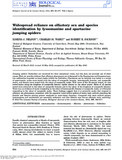Widespread reliance on olfactory sex and species identification by lyssomanine and spartaeine jumping spiders

View/
Date
2012-10Author
Nelson, Ximena J.
Warui, Charles M.
Jackson, Robert R.
Metadata
Show full item recordAbstract
Jumping spiders (Salticidae) are renowned for their exceptional vision, but this does not preclude use of other senses. Here we provide evidence that olfactory pheromones are widespread in the Spartaeinae and Lyssomaninae, two subfamilies regarded as basal clades within the Salticidae. Pheromone use by salticids was tested in a series of experiments: males were tested with the odour of conspecific females, heterospecific females, and conspecific males, and females were tested with the odour of conspecific males. With seven of the 29 species tested, we also tested males using the draglines of conspecific females (spider absent) as the odour source. Males of all species tested were attracted to the odour of conspecific females and to the odour of the draglines of conspecific females. There was no evidence of males responding to the odour of heterospecific females or conspecific males, or of females responding to the odour of conspecific males. These findings suggest that it is primarily males that respond to olfactory sex pheromones, consistent with the apparent trend within spiders of males more actively searching for females and females placing greater emphasis on mate-choice decisions. Compared with most salticid groups, lyssomanines and spartaeines are unusually sedentary and this lifestyle may favour olfactory mate searching.
URI
https://academic.oup.com/biolinnean/article/107/3/664/2701645http://hdl.handle.net/123456789/2960
https://doi.org/10.1111/j.1095-8312.2012.01965.x
Collections
- Journal Articles (PAS) [285]
